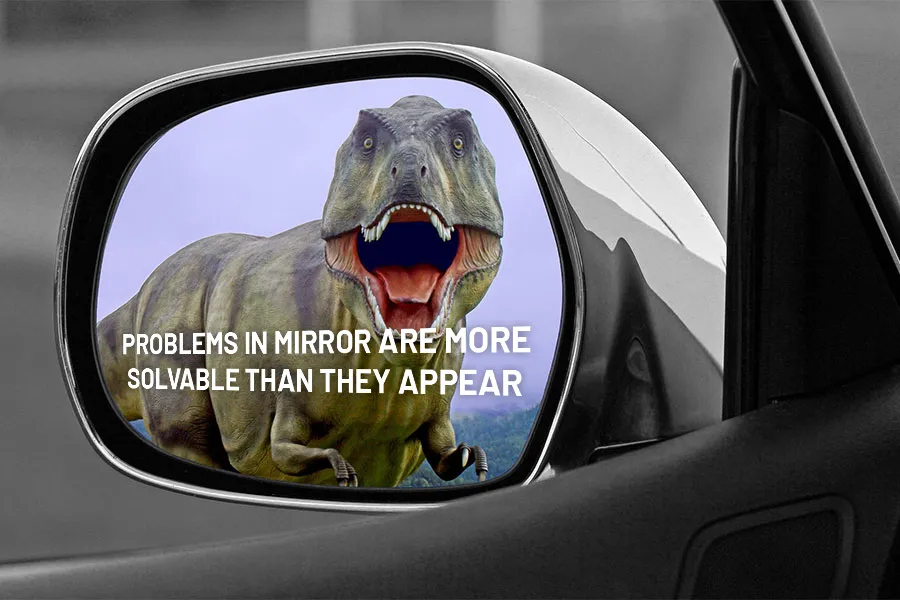Over the years, we’ve been offering helpful tips and best practices advice through our branding blog. Here, we’ve collected a number of the more salient points and are presenting them as a marketing reality check. A good number of these apply to new or small businesses. But you’ll also find that some of the largest corporations in the world take many of the same missteps. The first reality check is that none of us are immune from making the same mistakes. Those who learn from them are better poised to succeed.
Reality Check #1: The bankruptcy courts are full of great ideas that were undermined by insufficient branding and marketing.
There are countless stories about those who had a great product but took a “build-it-and-they-will-come” attitude. They assumed they would get noticed just by showing up. They assumed their market would immediately understand the benefits of their product or service. They assumed the product would sell itself. And a good portion of them ended up in bankruptcy court because of those assumptions.
Like the old Head & Shoulders ads stated, “You never get a second chance to make a first impression.” So, it’s best to take your best shot and position your business right from the beginning. Every great idea deserves a great start.
Reality Check #2: Marketing is a pre-requisite to profitability.
All of the research, hard work, time, talent, and money invested in starting a new business should never be taken lightly. It’s too bad many early-stage and startup businesses fall short when it comes to investing in their marketing. It’s not unusual for cash-strapped start-ups to view marketing as an “expense” that they’ll get around to once they become profitable, and then follow a percentage-of-revenue investment model. Often, instead of hiring a professional, they “home-spin” it and it misses the mark. Or they under-fund it and go unnoticed.
The reality is that this is, arguably, the time for the most aggressive marketing. Just like developing your legal, accounting, operational, and personnel strategies, the cost of bringing your product or service to market should be prioritized like any other foundational step of building a business. In fact, a good rule is to invest about 10% of your start-up money into marketing and begin about six months prior to hiring your sales team. There are numerous independent surveys where CEOs stated that, if they could do it all over again, they would invest more in marketing. Succeed or fail, at the end of the day, you should be able to step back and say that you gave it your best shot.
Reality Check #3: Home cooking is great, except when it comes to marketing your business.
Like any great chef will tell you, presentation is a vital contributor to a meal’s palatability. The same can be said about your business. If you’re home-cooking your company’s marketing communications because you feel it’s “good enough to get by” or “too expensive,” to outsource, it might not be the ideal recipe to whet your market’s appetite. Consider engaging a trained professional to bring an outside perspective and help you freshen things up. Doing so will also free-up time you can be spending making money on what you do best.
Reality Check #4: Good enough is no longer good enough.
Everything from desktop video production and stock photography, to Google Apps, CMS websites, and AI have widened the pool of available technology to a larger and, to some extent, less-sophisticated user base. Today, more and more small businesses are employing tools and tactics that they previously considered unattainable due to the costs or learning curves associated with them.
One risk that comes with these commoditized platforms and services is that they tend to bring contentment to those who feel they finally have what they need to get by. Unfortunately, the reality is that it’s “good enough” only if their competitors feel the same way. And, chances are they don’t.
As the saying goes, “The more things change, the more they remain the same.” Those who can harness new technology without losing sight of the basics, like branding, creativity, and targeted promotions, will be in a position for greater success than those who find contentment with what they consider, “Good enough.” Always assume that your competitors are being more aggressive than you are. Contentment leads to complacency, which undermines growth.
Reality Check #5: Your prospects won’t care about you until they believe that you truly care about them.
Without genuinely understanding your audience — sharing their concerns, knowing their fears, and feeling their pain — how will you be able to address their needs? How can you begin to manage and fulfill their expectations? How will you be able to connect with them on a practical, or even emotional, level if you don’t really know them?
We all tend to get too close to what we do and fall into the trappings of our own subjectivity. Therefore, it’s vital that you extract yourself from the “bubble” to gain a broad perspective. Doing so enables you to meet your market at their level. You should enter their world instead of trying to pull them into yours. Moreover, you’ll learn that your audience is far broader than your immediate sales prospects. There are influencers, analysts, potential investors, colleagues, recruits, and even friends and family who deserve to know what you stand for, what you offer, and why it matters.
Reality Check #6: Packaging is everything.
You need to show your audience that you have your act together. If you offer a cool product, you better have a cool web site. If you’re offering services to a unique audience, make sure you’re presenting your business in a way that demonstrates its own uniqueness.
The way you present your business is vital. Ultimately, delivering on your promise is what it’s all about. But you’ll get no chance to deliver without first connecting with your prospects in a way that looks great, identifies with them, demonstrates your relevance, and communicates why they need what you have to offer.
Reality Check #7: Most buying decisions are emotional.
Take a 30,000-foot view of what you’re really offering. Instead of focusing on WHAT you do, focus on WHY it matters and to whom. Whether you’re selling cars or high-tech widgets, your message should not be about you; it should be about the consumer. And it should play into their emotions. Perhaps, there’s a “peace of mind” gained in knowing that a certain problem is being solved. Or, maybe, it’s some form of economic “relief” that the buyer will experience. Or some other pain point that is being “cured.” It could even be about enabling them to spend more time on things that bring them the most happiness. Empathy is your most powerful sales tool. Use it to your advantage. Understand the emotional buttons of your audience and communicate how you can make their lives easier.
Reality Check #8: True leadership is in knowing when to follow.
Nobody can be right 100% of the time. You cannot possibly know everything. That means there are times when you’ll need to yield to the expertise of others. Even the best pilots need a navigator to help them avoid the turbulence of going it alone and flying blindly over new territory.
The more experts you keep in your circle, the better you’ll be at succeeding with your next great move. And, the better chance you’ll have that your crew will follow and grow with you. Even if nobody else understands your business better than you do, the bottom line is that you just can’t do it all by yourself. So, the next time you’re at a crossroads, it might be best to stop, look around, determine where you really need to be, and show the humility to ask for directions.
Reality Check #9: Chances are that you’re not the best. There can only be one best.
Accept the fact that you’re likely not the best at what you do. So, stop telling people you are. It’s simply not believable. Instead, tell them how you do things differently and why it matters to them. Remember, you are the only person in the world with your unique experience, talent, and passion. Those qualities add real value to what you offer and distinguish you in a positive way that is meaningful to your market. But, leave the accolades to others by earning them. Praise is only credible when it’s in the words of others, anyway. If you do your job well, there will be plenty to share.
Reality Check #10: The last thing they need to hear is all about you.
Many businesses make the understandable mistake of promoting themselves and their product features when they should really be speaking to their audience about how they can benefit from them. While this might seem elementary to some, entrepreneurs are often too close to their products to realize the emotional connection they need to make with their audience. They may fall short of the high-level vantage point that enables them to uncover who they really are, what their greater purpose is, and why it matters.
Taking a “brand’s-eye view” of your business will gain you a clearer understanding of both your market and the competitive landscape and provide a platform on which to differentiate yourself and demonstrate what makes you the better choice. And, it will help reveal what they really need to hear.
Reality Check #11: B2B blogging is for sharing, not selling.
People don’t read business blogs for sales pitches. They read them to be educated. A blog is one of the best opportunities to share your subject matter expertise and, by doing so, indirectly promote your business. But, if there’s no, “What’s in it for me?” from the reader’s perspective, you’ve missed the mark of how a B2B blog should work. If your posts read like commercials, guess what? People will tune out. This is a common mistake that even some of the smartest people make. But it’s not wasted energy; it’s simply misplaced. Save the direct selling and promoting for another time and place.
Reality Check #12: You cannot be all things to all people.
Wal-Mart can’t even make such a claim, so why should you? By casting the widest net possible, you’ll obscure what makes you special and dilute your brand. We’re not suggesting that you abandon all the other stuff and present yourself as a one-trick pony. Instead, use what you’re truly great at (remember, not the “greatest”) as your marketing foundation and reinforce it with everything else that adds value. Just like your workload, your message needs to be prioritized and uncluttered. Use your unique strengths to make your mark and distinguish yourself from your competition.
Reality Check #13: Free consultations are a weak call to action.
Everybody offers free consultations. So, they have no real perceived value. It’s okay to offer them. But they are ineffective as a call to action. Information is what people want. Educate your target audience and market influencers by offering free advice, tools, and tips through webinars, blog posts, whitepapers, downloads, etc. When people feel they’re learning from you, it positions you as the subject matter expert. This brings great value to your brand and makes prospects more inclined to jump into your sales funnel when the time is right. They’ll remember those times when you helped them.
Reality Check #14: Your logo is not your brand.
Understandably, many businesses mistake their logo for their brand. It’s a common perception left over from the days of branding livestock. But times have changed, and so has branding. The logo merely symbolizes the brand; it’s the brand mark. The brand transcends the products or services behind it to reflect a greater sense of purpose while connecting emotionally with the audience to create a unique frame of mind. In short, your brand is your promise and ability to fulfill it. It’s what people think of when they hear your name.
Reality Check #15: Marketing communications is not a democracy.
It’s purely strategic. It’s based on research, data, and even philosophy. It relies on experience, best practices, and talent. It is not something to be trivialized by giving everyone equal say. Never, ever hold a vote. Many of those who “vote” are typically driven by personal preferences instead of strategic objectives. That includes the top brass. Sure, they have to buy into it. But, let the marketing team make their case. If the decision-makers cannot be sold on it, then Marketing hasn’t performed their due diligence of research and self-critique.
BONUS REALITY CHECK: The entire preceding list is 100% within your control!
Hopefully, you aren’t falling into many of these traps. But, the final reality is that we’ve ALL taken similar missteps at one time or another. Possessing the humility to identify them and ask for help is the first step towards undoing them. If you need help sorting things out and prioritizing your marketing efforts, or just want some objective advice about how to address them, drop us a line.
Related Posts
I’d like to learn more about how you can help me, but …
If any of these scenarios are raising concerns about the effectiveness of your marketing communications, step 1 is up to you.
The one thing we all share and what to do with it
Even if you’re selling widgets, there’s something more than you offer that distinguishes your business in a positive way. It’s what your customers truly gain from you that they can’t get from anyone else. This defines your business more than anything.
Startup branding needs to be done right out of the gate
The bankruptcy courts are full of great ideas that were undermined by ineffective branding and promotion. Build it and they will come? No, they won’t. Not unless you make them really want to. Or, better yet, need to.
Never assume anything
Never Make Assumptions about Your Audience. That seems like an obvious rule, right? But, we all do it to some degree. It’s human nature. We follow our gut instincts. We proceed without having the data to back up our actions. Remember New Coke?
I’m your potential customer and these are the things I care about.
You seem to be great at what you do. You have a terrific product. Your media coverage has been impressive. You’ve been serving the industry for decades. But, what does it mean to your customers? What’s in it for me?
15 ways your website could be hurting your business … and what you can do about it
Even if you’ve been able to put a check mark next to that spanking-new website on your marketing to-do list, get out your eraser. Your work has only just begun. A successful website is never once-and-done.







